Portrait of a tube
ECC803S - ECC83 - E83CC
JACMUSIC. Since 1993. All rights reserved. Copyright note
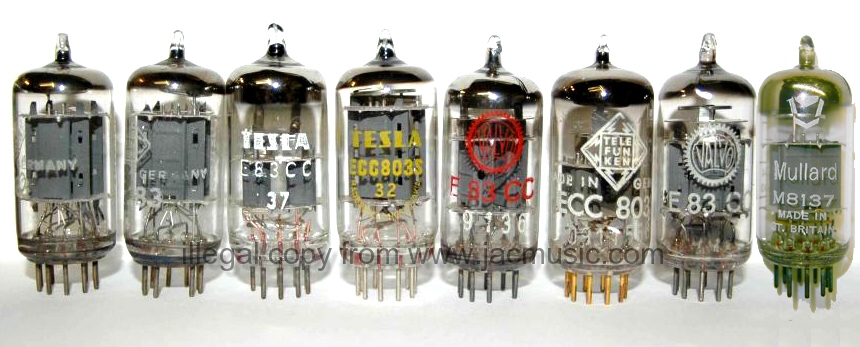
From the left to the right:
Contents
- Introduction
- The BIG Confusion with part numbers
- SECRET process or PATENTED process?
- True-Qualifications
- Overview of some part numbers
- Link to the BIG tube test
- About testing in general
Introduction
A discussion about opinions. There has always been the mix of opinions from l people who can hear things, which can not be measured, and the rationality of people who say you can not hear what is not measurable. Things become difficult when an rational hardliner wants to make emotional users look silly for not understanding electronics. Whereas the emotional users, say they trust only their ears. Those two worlds are so different.
A re seller of NOS tubes may supply a full set of excellent test data, and may get the tube returned by somebody who does not know the difference between Volt and Ampere, but the tube sounds not as expected.
Or, just as well, very good sounding tubes get returned by a tube professor, who studied every detail of the test data in depth, and finds a detail which to his opinion is abnormal. He feels insulted, by being send tubes which should have never left the factory.
Some sellers reverse the game, by giving subjective test results, such as natural sound, low microphonics, tight bass, and high resolution, etc., on a scale from A to D. So the emotional buyer gets what he wants, and the tube professors have nothing to complain about.
Myself I am somewhere in between of all this. What is a valid argument for one person, is invalid for another. So yes, we all know JJ makes low cost copies of popular tubes, and some prefer those for price reasons, while others avoid them for quality reasons.
Today, we see a growing group of " investors", well aware that historic tubes do not loose their value anyway. If they buy a pair of NOS tubes which sound really good, they re order a few pairs as an investment.
Myself, I had a few times l bad experiences with JJ tubes, and that triggered a factor inside myself, saying JJ is only good to save money. I have an RFT ECC82 tube in the percussion amplifier of my 1955 Hammond organ, and only with that tube, the percussion of the organ sounds as sparkling as it should. So if that tube dies, I want another one just like that. I would pay any crazy price, if that was the way to retrieve that special sound. Any discussions about data sheets, at such a moment you don't want to hear it. You just want your old sound back. I have similar feedback from a person with a guitar amplifier. He bought a quad of the expensive TESLA E83CC, and after finding out the amplifier sounded much better as ever before, he bought another quad, and later even more, just to have enough spares.
The BIG Confusion with part numbers:
ECC803S - ECC83 - E83CC
The best triode of it's kind, is by no doubt Telefunken ECC803S.
Availability. I have a copy of the Telefunken production book, with all part numbers ever made. In there it says, a total number of 16 Million ECC83 was made by Telefunken! Such an incredible quantity. Now TFK production is only a fraction of all ECC83/12AX7 ever made. This Telefunken number is nice anchor however! If we just guess, the worldwide quantity ever made was 1 Billion ECC83, this would mean TFK build 1.6% of this. Given, ECC83 is still made today even, in large quantity, this 1.6% is probably not right. So I think much more than 1 Billion ECC83 were made. From this perspective, the total quantity of TFK ECC803S ever made is really very small. Only 146000 pcs of TFK ECC803S were made from 1960 to 1973. What does this mean for NOS Availability? Lets make a calculation for this. From 16 Million Telefunken ECC83, enough are left put some 180 pcs on auction at Ebay daily. This quantity sure changes from day to day, but I counted myself that many pieces on the day I wrote this text. Given the auction runs one week, 9412 pcs are sold yearly. Which is 0.0006% of all TFK ECC83 ever made. Using that number for ECC803S, 0.0006% means 87 are for sale every year on Ebay. Given we see only 1...3 pcs per day, that number seems to make sense. So all those 10.000's of interested people, in the end worldwide need to fight over those 87pcs. Given they need often two pieces, only 43 persons can be served. And yes, that make it an expensive bid. Frankly, most of the ECC803S for sale, are refurbished, used tubes. Specialists add a new gold plating on the pins, and have the stamp renewed by special companies. Run the tubes through a regeneration program, and voila: they call it NOS ECC803S. Just a hand full of people worldwide, are buying real NOS ECC803S. Talking about rare... THAT is rare.
Compare this with E88CC.
If I look under E88CC (this tube is not the topic here), I see: 1081000 were made from 1957 to 1973. Now, both E88CC and ECC803S went only in industrial applications. So 7x more E88CC were made, compared to ECC803S. Here is something not logic with the supply situation: E88CC you can buy them everywhere. Some have them in boxes of 100, piled up at some (shady?) tube dealers. The supply if ECC803 I would expect to by 7x smaller in theory. But in reality, it seem 700x smaller. This is not weird, this is more than suspicious. I can only explain this by these thee situations:
- E88CC is faked on a large scale, including the diamond bottom.
- Or: ECC803S owners do NOT sell them.
- Both of the above at the same time.
The original buyer(s). I used to have contacts to a retired TFK sales person. He told me, the initial buyer was Wandel & Golterman in Eningen, Germany. For them this tube was constructed, for their test equipment. I know this company, I have visited them several times, when I was a sales engineer for Hewlett Packard, in 1990. Sure I can say, they were small by then, and they must have been even smaller in 1960 when ECC803S was made specially for them only. Many years later, the sales person told someone else, ECC803S was sold to Rohde & Schwarz in quantities. So at least he meant to say it was one of the two.
Technical, the TFK ECC803S has lowest noise, lowest microphonics, at high gain, and out of the box comes (as specified in the data sheet) a balanced and matched tube. It is matched so well that two random tubes, can be combined, and they are a balanced, matched pair. And all of that is guaranteed for 10.000 hours, so this number is the minimum run time.
Some say TFK ECC803S, it is the ideal tube. Well.... it probably is indeed, but extremely close come the vintage TESLA and SIEMENS E83CC . Anyway TFK ECC803S is rare, and per gram in the same range as gold.
Some basically very good web sites, describe the search for the -Holy Grail- Telefunken ECC803S as pure nonsense, and advise you to try out new made JJ equivalents because they are so cheap and also good. Well I did so, and this seemed not true. First thing that wondered me, is the silly JJ ECC803S datasheet. There is only basic information in there, even less as with standard ECC83 from old data sheets. For me, that is no ECC803S, as all the typical things that make this tube, is painfully missing in the JJ datasheet. Then, when testing them, the JJ tubes showed out of the box unacceptable t differences between the two triodes. At burn in, the did not improve, but instead of that, they started to reduce plate current significantly, after just a few hours. So I stay with my opinion about JJ tubes.
As far as the sky high prices are concerned, personally I can understand, if somebody has a 25000 Dollar Allnic phono amplifier (yes!), and 20.000 Dollar Avantgarde speakers, they are not interested in saving 1000 dollar on the tubes.
Here is a story I was told by phone in June 2019, and I have no way to check if, but the person was very knowledgeable, and he knew a lot of details. When production of tubes was stopped by Telefunken, they had a serious problem what to do with the old stock, as it was suspected to contain poisonous chemicals. So it was stored in containers at first, and stayed in there for a long time. From there, some people removed on their own behalf many tubes, which was tolerated, because what was gone, was gone. From those containers, a person who later lived in Bonn, stored a large quantity in his private house, and kept it for decades. Amongst that were told to be few thousand ECC803S, in original 100 master cartons. He sold sometimes tubes to friends, but generally was reluctant to do any business. After he died, his son sold everything to Asia. I have no hard way to verify this information, but there were so many other details in this conversation, not all of them repeated in this text here, which I know are really true, and I regard it one of the most trustworthy informations I ever received about ECC803S.
A similar situation has happened with the Siemens E88CC, once told to me in the year 1999, by Roland Kraft, writer for "Image HiFi" Magazine. After production was stopped, large quantities of E88CC were dumped in containers, ready to be scrapped, at the München Factory. Employees took many home with them, to save them from being scrapped. However the story of ECC803S was the most detailed.
WARNING FOR ABUSE OF THE ECC803S and E83CC PART NUMBER. DON'T LET ANYONE FOOL YOU!
SECRET process or PATENTED process?
The results of secret processes are inside the bottle, such as: What cathode material to use, how to prepare the base chemicals for that, how to store them, how to mix them before use, how to apply it, and many things more.
A good cathode is one of the most difficult things, if you keep in mind that preparing basically 'good' cathode materials at all is a major problem today. Have you ever heard of new made factory balanced ECC83 with a guarantee that this lasts for minimum 10.000 hours? Of course not! They have no idea how to do that.
The sky high price is because NOS is hardly found. So this inspires the few remaining tube factories to reproduce them in some sort of a way. While doing so, here comes the problem: There is NO WAY to come even near the historical specifications. Processes have always been secret. Reason is, you can either patent a process, or keep it a secret. Like the aroma mixture of Coco Channel No5 was always a secret. Also the Coca Cola recipe was never patented, but stored in a vault, to which only a just a few people have access. Patenting protects against copying, but not really. It also means you need to publish the recipe, it is in the patent papers, which is public information. So everybody can even infringe the patent, whereas without this recipe, this was impossible. So Telefunken keep many details a secret and never patented it.
We do the same at the Emission Labs tube factory. We have processes to improve particular things, and even proudly saying what we improved, would already help the competition. Worse would be to publish how and why this works, and even pay yearly patent fees for this. The Chinese would have a good laugh about it.
 Patent the recipe, the patent is valid 25 years, and after that the patent is a free legal recipe for others to copy it. Do you want that? No!
Patent the recipe, the patent is valid 25 years, and after that the patent is a free legal recipe for others to copy it. Do you want that? No!
How would you like to prepare those ultra special multi layer cathodes. All the old men at TFK who knew the tricks have died. Machines and production instructions are scrapped 50 years ago. Manufacturers of chemicals are gone, and if not they do not even know what you talk about when you ask for it. Then the special cathode sleeves, of a material purity and precision that we can say definitely for sure: No company on earth produces this anymore. Try to order gold plated grid wire of so any so many microns, and this and that ductility, and 99,995% purity, produced under vacuum, and whatever. If you ask today, they have only have fun about you.
So the days were real ECC803S was produced are gone, and that is permanent. I do expect the re-boxing re-stamping fakers to make NOS tubes from used tubes, but that is another story.
![]() WARNING FOR FAKE TUBES. DON'T LET SOME HONG KONG EBAY SELLERS FOOL YOU WITH SO CALLED ECC803S, THAT ARE FAKE. NOW THAT YOU KNOW TO LOOK AT THE CONSTRUCTION ONLY.
WARNING FOR FAKE TUBES. DON'T LET SOME HONG KONG EBAY SELLERS FOOL YOU WITH SO CALLED ECC803S, THAT ARE FAKE. NOW THAT YOU KNOW TO LOOK AT THE CONSTRUCTION ONLY.
So here we are, and marketeers in today's tube factories see those ECC803S sell on Ebay for 1000 Euro one. It is obvious they seek a part of the profit. Only thing is, they take a plain ECC83, gold plate the pins, stamp it ECC803S, but most people call that a fake.
True Qualifications
To be as qualified near Telefunken ECC803S, a new made tube must at least show these things:
- It is a FRAME GRID tube. Study this item carefully if you are interested. These are masterpieces of mechanical design. If you click here, down at the page is a microscope picture of a frame grid, with a fine measurement scale. The fine stripes are 0.1mm and as you can see, such a grid wire is perhaps 1/5 or 1/10 of that. So in the range of 10's of micrometer.
- The two triodes inside, must have less than 15% plate current difference, as written in the Telefunken datasheet. So they are 'balanced' per definition.
- 10k hours minimum lifetime, during which time the datasheet. is compliant. Clearly written so in the datasheet. of course.
- All important parameters have minimum and maximum values. For instance grid leakage.
- Low microphonics specified in such a way, you can VERIFY it.
- Can be used in stand by as long as yo want, and no cathode detoriation will take place.
- Shock proof, also in such a way that you can VERIFY it. That means acceleration is specified in 'g', and the noise result which this produces. So if a company writes 'low noise' tube on it, that is better than nothing, but for an ECC803S they should say: How low, and how tested it, and what is the minimum acceptance level. That is ECC803S. All other tubes are ECC83 in an ECC803S jacket.
Let me explain here what a frame grid is, and what's we think at jacmusic.com what is so nice about it. Perhaps you have opened up an old radio tube, and removed the grids one by one. When you touched them with your thick fingers they were damaged. Specially the very fine ones. Well not so with a frame grid! With a normal (none-frame) grid, the grid wires are used to keep the grid bars in position, right? This may seem kind of natural, but there are other ways to do it. A non-frame grid needs a minimum diameter (=strength) of the grid wires. If they get too thin, the grid would get too sloppy. However, for miniature high gain tubes, you need thinner than thin wires, and for high transconductance you need them closest to the cathode. Here is where frame grids come in. So they make first a FRAME from hard metal, mostly Molybdenum. The frame stays inside the mica. Around this frame the grid wires are wound. This method allows extremely thin grid wires. You will think: 'So what?' Well.. for HIFI something very very nice comes in, and THIS is why people like frame grid tubes so much. Frame grid tubes have a very interesting kind of microphonics. Look at a guitar... the thin strings give the higher tones. And of course more tension makes the tone higher... and shorter strings have higher tones too. Now in a subminiature frame grid tube, like TFK or TESLA, all these things come together. The wires are so thin, and tension is so high, and they are so short, that they have a resonance frequency above 20.000 Hz. This makes when you knock on the Audio frame grid tubes like TFK ECC803S, you hear not 'dingggggggg' as only any regular ECC83, but you hear only a dumb noise like 'zmb' and that's it. The tube will never environmental noises, no matter of the gain is 100x. Once you experienced the difference, you will ask with any tube: 'Is it a frame grid tube'. Well unfortunately the answer is 'No' with most of the tubes. And now you understand why I say, some manufacturers feed this hype with non-frame grid tubes.

6922 Frame Grid (Spanngitter)
Overview of higher Quality ECC83
So, to reduce the confusion, here is a nice overview of what is available. Always keep apart the CONSTRUCTION and the BRAND and the part number, as these are different things, and you CAN get confused easily. .
We are only interested in the construction here, not so much under which brand it was available, and not what great part numbers they stamp today on regular standard tubes. The brand is only on the outside, but the thing to find out, what we have on the inside!

6922 Frame Grid (Spanngitter)
FRAME GRID extracted from a 6922 tube
First there is the Philips Long plate. I always use to say, the child called 'success' is claimed by many fathers. You see this tube on position 5 and 7, in the picture below. Because it's so successful, it is found in the family of Valvo, and SEL, and Siemens, and many more. Telefunken had a similar baby, but from their own production. These are on position 1 and 2. It's a good tube, but no frame grid.
The Telefunken ECC803S is a special tube. It is a FRAME GRID tube, in German called 'Spanngitter'. we think at jacmusic this is where the 'S' comes from. The FRAME GRID allows extremely thin grid wire, and extremely small distance between grid and cathode. Besides the grid dimensions are very precise. Ideal to make a high gain miniature audio tube. Only making frame grids is not everybody's business, and so far I have seen this technology with ECC80S only at TFK and TESLA. The Frame grid was initially used in so called Planar tubes, which work as very frequency. It was first used in 1952 industrially with the C3g tube, some call it the finest tube ever made. (More about C3g here). This technology was later used in ECC803S as well.
You can recognize the ECC Series frame grid tubes by their typical shape of the plates, and of course by the frame grid. The plates of frame grid tubes reach extremely close to the grid, and this is done by the 'pit' you see stamped in the middle of the plates. So the plates are kind of boxed always, and there is a pit in the middle. Look at position 3, this is the TESLA frame grid version. So it has those short, cubicle shaped plates. You think you see a large plate distance, which is not true. The real plate distance from parts of the plates in the middle which actually come every close to the grid.
Frame grid tubes are more precise, and more expensive. Normal grid can be made with thinnest wire of 100u. Would you use thinner wire, you get unstable constructions. For manufacturing a frame grid tube, first a frame is made, and around the frame wire of 8...10u diameter is wound. Note, that this is thinner than the human eye can see. If you take apart a broken frame grid tube, you can almost "easily" remove the grid. Simply because of it's frame. Since the human eye can not see this thin wire, you see only a gray opaque layer, as if there is some foil. Only with a lens you can see the wires.
Comparing ECC83 Tube brands and reading datasheets
What you should do is look at the following:
#1 Read the Text description in the data sheet.
Read at the first page about Reliability, Long Life, Tight tolerances, Vibration and Shock (both!), and the special cathode. So they do not just say 'Vibration proof, but they say you can apply 2.5g acceleration at 50Hz vibration a the tube works normally. Also with reliability they do not say say 'high', but they guarantee a failure rate of 1.5 per 1000, per 1000 hours. This is INCREDIBLE GOOD. It means after 10x 1000 hours, still 985 tubes are within specifications. (See next part). Those that are not within specifications are not necessarily dead, but just is outside one of the very tight limits for ECC803S, and may still test 'good' on any tube tester.
From what I know, the frame grid technology was invented by Siemens in Munich. I have read unconfirmed stories how the R&D engineers in Munich very carefully hand carried the first samples of the unprotected grids from the one floor to the other, while even this handling could damage the grids.

Click here for a full version pdf
#2 Check the TOLERANCES in the data sheet
Specified tolerances is the second leg, ECC803 Stands on. So not just 'typical' as with normal ECC83. Look what it says under the number '250' (plate voltage). You should use a 1.6k cathode resistor and then will measure typical 1.25mA, and deviation is maximum 0.15mA. Mind you this is an auto bias specification, easier to meet than a fixed bias specification. Still, they dare say what is a test setup, and what are the limits. I tried to get this from Electro Harmonix, it was impossible.
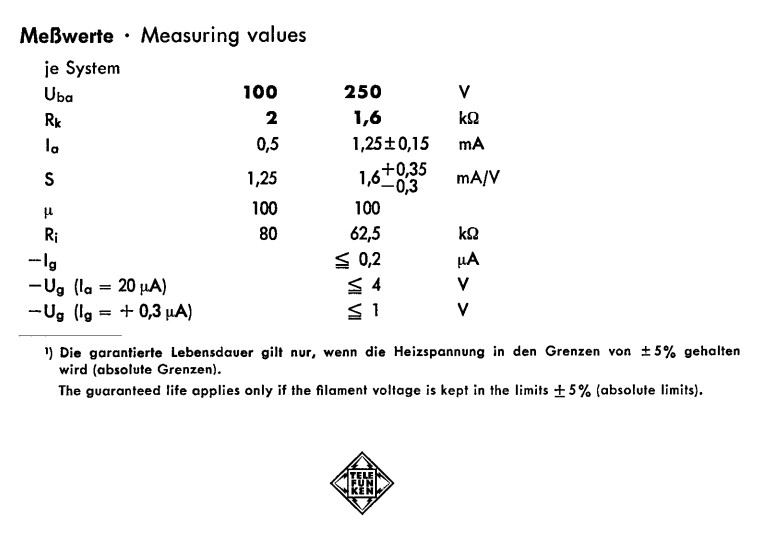
#3 Check the END-OF-LIFE specification in the data sheet.
End of life is normally specified by the Gm and Ia value going below a certain value. It may specify how long this will take, and it may says what heater voltage tolerance is needed for this. Things like grid current tolerance is something which is valid always for those SQ tubes, but generally do not indicate the end of life.
VERY IMPORTANT: For end-of-life tests, there is usually an test circuit needed. This is so totally obvious, that the circuit is most of the time NOT drawn in the data sheet. Instead of that, they tell you the Cathode resistor, and a SPECIALIST will recognise this immediately as auto bias.
It is so painful, that people refuse to read data sheets, or buy digital tube testers, and can not test for lifetime, because that has do be done in auto bias mode. They do not even notice, and test the tubes with fixed grid voltage, because that is the only thing the tester can do anyway. Also for that reason of course, the tube tester manufacturer does not speak about such shortcomings. Please look at the above table, simply from the Telefunken ECC803S data sheet. Such data sheets are so clear. It gives two tables, one at 100V, and one at 250V. The 250V table has also tolerance on it. So if you want to check a random tube for it's lifetime limits, that is the table one to take.
The second line also already says: Rk = 1600 Ohms. So that is the auto bias resistor you need to take. What grid voltage do you need? Can you see it in the table? No, of course not, because it's auto bias. Then you see, the plate current is 1.25 +/- 0.1 and Gm = 1.6 +0.35 / -0.3 for a good tube.
It becomes really foolish, when people use digital testers, simply set the grid voltage for 2 Volts, because they find that under 'average' results, and then REVERSE the meaning of the word average! They (self) define that as a 'must be', fixed value, and blatantly bias the tube at 250V anode, and -2V grid, and with THIS setting measure the plate current. Now of course, and logically, no data sheet tells you to do this. Just now the operator who still does so, has a problem of course. His results can not be interpreted. But that doesn't stop them from creating alternative facts. They just take 10% or 25% or whatever they think is right, and reject tubes kind of randomly with this self made test setting, and self made test. I am not nagging or joking about this. It is so foolish, but I think 95% of the tubes which are digitally tested by 'specialists', are tested WRONG this way. Folks, it is like this: There is NO REPLACEMENT for an auto bias circuit when it comes to life time testing, and I only say this because I see all the big companies like Philips and Telefunken writing in their SQ data sheets, this is how to test. So they write this in such data sheets which have life time in the specs. But from Philips or Telefunken, and from NO MANUFACTURER on the whole world, I see nowhere you must use a fixed grid voltage. Not for life time testing, and not for any other testing. The only exception I know is with 1920's battery radio tubes, intentionally made for fixed grid voltage which was equal to the heater voltage.
Here is something which will make you realize better what I mean. Compare the Telefunken ECC803S datasheet, with the (new made) Tung-Sol ECC803S datasheet.
PREMIUM TYPES
Unfortunately, the premium type part numbers are used by today's manufacturers, suggesting it is the same.
1) JJ ECC803 datasheet (New Production)
Lets just begin with the worst if all. As you can see here JJ datasheet looks like a plain commercial ECC83 datasheet, and has not much to do with Telefunken ECC803S.
Conclusion: Literally everything what makes the TELEFUNKEN ECC803S what it is, it is completely missing in the JJ DATA SHEET for the full 100%.
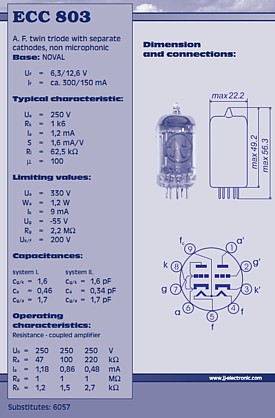 JJ made full reproductions of several TESLA tubes at the beginning of their production. They used a licence for the TESLA brand name, and only later on they changed to JJ branding. So we can say from the beginning period, they had all the stamps, and boxes etc. This makes it difficult to keep apart GENUINE TESLA tubes from the JJ made ones. However, it is clear, that collector's value of the GENUINE TESLA is going up very much the moment, whereas the early period JJ made, (TESLA branded!) tubes, have a low value, and I see them not considered interesting by collectors of NOS tubes, since this is not TESLA NOS at all. So you do need to keep this apart carefully, but it is difficult.
JJ made full reproductions of several TESLA tubes at the beginning of their production. They used a licence for the TESLA brand name, and only later on they changed to JJ branding. So we can say from the beginning period, they had all the stamps, and boxes etc. This makes it difficult to keep apart GENUINE TESLA tubes from the JJ made ones. However, it is clear, that collector's value of the GENUINE TESLA is going up very much the moment, whereas the early period JJ made, (TESLA branded!) tubes, have a low value, and I see them not considered interesting by collectors of NOS tubes, since this is not TESLA NOS at all. So you do need to keep this apart carefully, but it is difficult.
2) TESLA E83CC, made by JJ
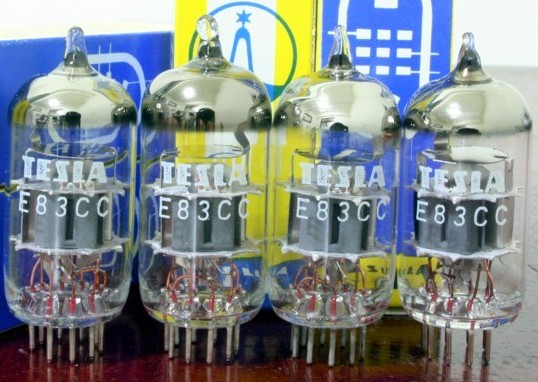
Now with my not so good opinion about JJ, here is one major exception.
When TESLA stopped production of small tubes, the TESLA machines went to JJ, along with a limited licence to use the Tesla brand. (These machines went from Telefunken to Tesla before that)
Only for a short time, JJ was using the TESLA brand. . So on the market is now,
- TESLA E83CC by TESLA
- TESLA E83CC by JJ.
Such JJ tubes are getting a collector's value now, because they are 35 years old already, and made with the TESLA machines and chemicals.
The main optical characteristic of the GENUINE TESLA is the different shape of the glass dome at the top. JJ made TESLA have a more round dome. The GENUINE TESLA have often a darker kind of getter flash, though sometimes the shiny flash was used also. If you see the darker flash though, you can say right away: GENUINE TESLA. Once you learn to see the differences, it will be the first thing you look at. Also when the seller has the original old, dusty, bulk packs of the E83CC TESLA, it is another sign of trust. Also read this article about faked tubes on this website.
 JJ also copied this confusing part numbering system, without any need. It was a big mess, I can not quickly explain that. Click the button for more information: . Some more information here
JJ also copied this confusing part numbering system, without any need. It was a big mess, I can not quickly explain that. Click the button for more information: . Some more information here
3) The Tung-Sol ECC803 datasheet (New Production)
Tubes that I have tested, were plain ECC83, om ECC803 boxes, and ECC803 printed on it
4) E83CC WEST GERMANY PRODUCTION
 This tube is a hidden treasure. Made by Siemens & Halske only, it was sold directly as such, and also re branded as VALVO.
This tube is a hidden treasure. Made by Siemens & Halske only, it was sold directly as such, and also re branded as VALVO.
Regardless the brand, SIEMENS or VALVO, they all have the Siemens & Halske Symbol: #, the so called small printing, on the glass. This is a small series of codes, burned into the glass under high heat. A quick refer to this tube is the "Triple Mica", which is indeed a third mica plate in the top, same as Telefunken did with their famous ECC801S. The tube E83CC is something really special, because it is made with full compliance to the original TELEFUNKEN ECC803S datasheet. And not just that, it EXCEEDS this data sheet at some points even. The one pictured heres, is Valvo branded, but the small printing shows the Siemens&Halske # symbol, as they all have.
Please note this: When there is no third mica, it is not a real E83CC, and also the "small printing" can not be faked. This is fantastic, NO FAKES are around.
With German NOS E83CC. we find all of the goodies written in the data sheet, a small extraction is:
- Long Life (10k hours)
- Low Defect rate, with guaranteed reliability data
- Low microphonics
- 500G Shock resistance
- Vibration resistance.
- Balanced by definition, specified in the data sheet. (Needed as Push Pull driver)
- No restrictions on low current or stand-by.
. 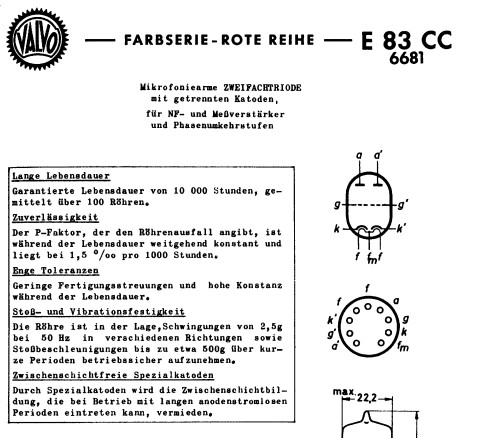
Positive: Differences I see, is the VALVO E83CC specifies the data even more complete than Telefunken, when looking at the capacitances, this is quite amazing.
Negative: When looking inside the tubes, it is clear this is no frame grid tube, but to compensate, they made it a triple mica tube.
Conclusion: A secret tip! Totally underestimated tube, full 100% compliant with the TELEFUNKEN datasheet.
5) The TESLA Versions
Now TESLA did something strange, everybody is still today confused about it. They REVERSED the part numbers for frame grid and normal grid tubes. It is crazy. So they even put the 'S' on a normal long plate tube.
There is the LONG PLATE TESLA VERSION, which is NO frame grid, but called ECC803S. There is the FRAME GRID TESLA VERSION, but called E83CC.
Don't try to understand the logic of this. There is none. It is Czech humor. Just work with it the way it is!
Frame grid tubes are more precise, and more expensive. Normal grid can be made with thinnest wire of 100u. Would you use thinner wire, you get unstable constructions. With a frame grid first a frame is made, and around the frame a 10u wire can be wound.
TFK ECC83: LONG PLATE <==> TESLA EQUIVALENT: ECC803S
TFK ECC803S: FRAME GRID <==> TESLA EQUIVALENT: E83CC
So at TESLA they REVERSED the TELEFUNKEN PART NUMBERING.
Everybody is (still) so confused by that.

GENUINE TESLA ECC83. Made in CZ Republic. So not RFT. This is not frame grid version.
I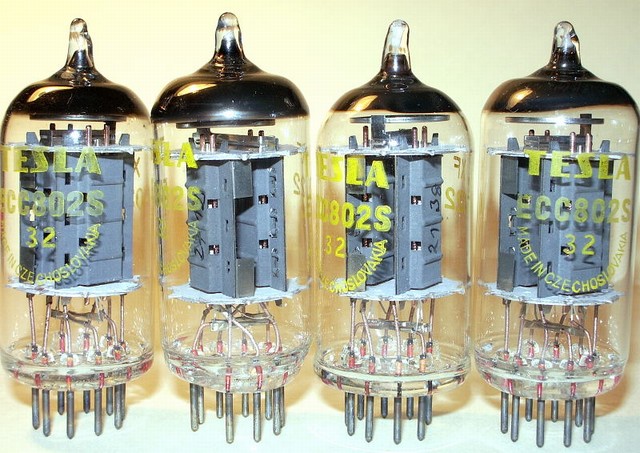
Original TESLA ECC802S. Tesla ECC803S looks the same
Note the somewhat flattened part of the dome, best visible with the last tube. The getter is darker colored as with JJ.
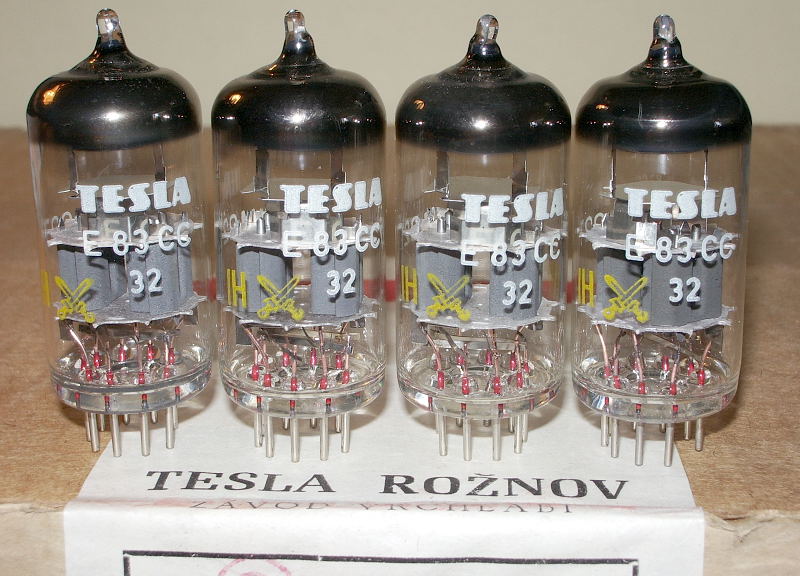
Picture of GENUINE TESLA made E83CC
Note the somewhat flattened part of the dome. The getter is darker colored, indicating GENUINE TESLA.
Here is a nice detail, and very interesting! In many cases, the TESLA pins are a little smaller diameter than normal, it can be 5....10%. You need a fine micrometer tool to measure that. I do not know the reason, but I have observed it many times. It is additional proof such tubes are not JJ. This diameter deviation if you want to call it such, I have also observed often with TELEFUNKEN E88CC which is almost identical construction as TESLA E88CC. Now, tube bases (the lower part, in factories called the 'coin' ) were normally bought from special suppliers. So most likely Telefunken and TESLA used the same vendor for this. It proves the close relations between TESLA and TELEFUNKEN.
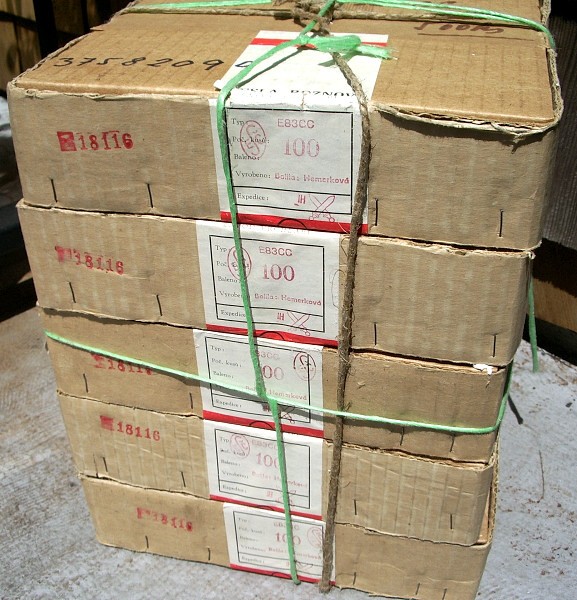
ORIGINAL BULK PACKS for TESLA E83CC. This is the normal way they were packed.
For a very detailed article about tube faking with TESLA tubes, visit the HALL OF SHAME, faked tubes
Conclusions:
- TFK ECC803S is the queen of high gain miniature triodes. Absolutely impossible to ever re-build it. Prices seen by me: 100€ in 1999, 200€ in 2004, 500€ in 2008, 1200€ in 2011, 800...1200€ in 2024, while I am editing this text.
- To my opinion TESLA (NOT JJ) E83CC frame grid tubes are the BEST you can buy, when you do not want to spend so much on Telefunken tubes. These are fully identical construction, and on same level with the TELEFUNKEN ECC803S tubes that they are cloned from. Same kind of price race here, but on lower level.
- What is of course good about JJ (I was asked to point out not only the negative here). Their tubes are really cost, for a price which really nobody can do. They offer a very low cost frame grid version called E83CC. This is true indeed. Yet also with this part number, E83CC is a Special Quality tube. If we take for instance VALVO E83CC as a reference, there are many things which makes this tube what it is. Yet in the JJ data sheet, they write nothing which comes even close to a SQ tube. So my objections stays. There is nothing against building low quality tubes for a low price. But yes, It is even good when such tubes exists, I agree!
![]() WARNING FOR FAKE TUBES. DON'T LET SOME HONG KONG EBAY SELLERS FOOL YOU WITH SO CALLED ECC803S, THAT ARE FAKE. NOW THAT YOU KNOW TO LOOK AT THE CONSTRUCTION ONLY.
WARNING FOR FAKE TUBES. DON'T LET SOME HONG KONG EBAY SELLERS FOOL YOU WITH SO CALLED ECC803S, THAT ARE FAKE. NOW THAT YOU KNOW TO LOOK AT THE CONSTRUCTION ONLY.

Hey--- what you see here are real ones.. :)